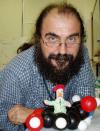| Online: | |
| Visits: | |
| Stories: |

| Story Views | |
| Now: | |
| Last Hour: | |
| Last 24 Hours: | |
| Total: | |
After the ISS Chat
The link (through Amateur Radio for the International Space Station) was crackly, but the cadets of the Air League were speaking to Astronauts through a signal bounced from Adelaide to Brisbane to Hawaii to over 200 Km into space. Astronaut Koichi Wakata answered the kids questions thoughtfully.
And then it was over. The kids had 10 minutes of Austronaut time and they were stoked.
I was on after the tea break, following an actual astronaut is a hard act, but I think I pulled it off.
I spoke about seeing the ISS, but I looked at the number of ways you can see it. I started from the point that I was born a year before the first satellite was launched, when I was the same age as most of the Air Cadets, Space stations were science fiction, like Stanley Kubrics Space Station V.
The ISS had its 15th birthday last year, that means for most of the air cadets, there was never a time in their lives whe there was not a fully manned space station circling above their heads. For these kids, my science fiction was their reality.
I then talked about the contrasts of the space stations of our imagination and realty, comparing the spare, white station of Kubric with the messy human habitat that is the ISS. I added in the ISS as portrayed in the Big Bang Theory and Gravity, and how the ISS is seen through outreach programs.
Finally I talked about how to see the ISS in the sky. Then we all packed up an it was over.
As I walked home under the stars, with Jupiter shining brightly I wondered if someday one of those kids would be standing where I stood, maybe talking about space elevators, where their science fiction has become reality.
Source: http://astroblogger.blogspot.com/2014/02/after-iss-chat.html



